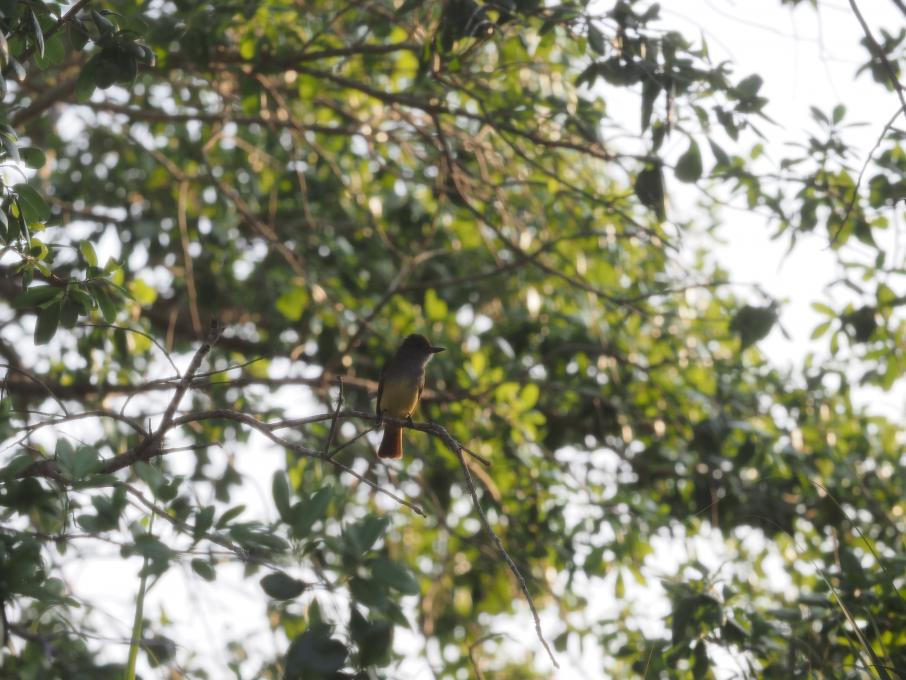Richard
Forum Replies Created
Viewing 20 posts - 1 through 20 (of 20 total)
-
RichardParticipantHelping Birds in my world Activity 1 & 4 Why do birds matter to me? And what’s next? I studied Physics in school and went to work in the Semiconductor Field after graduate school. I read thousands of journal articles during my career and every issue of the 50 years or so of National Geographic that came to my various homes, but very little fiction. Birds were an incidental part of my perennial interest in all of nature and how it all works together. As a child I was a hunter gatherer, turning over rocks and sticks and logs looking for the creatures that lived in the earth and trees and waters that were around me in my hometown of Worcester MA. At various times I had collections of snakes and turtles and frogs and salamanders and crickets. Birds tended to be uncatchable so the only birds I had close contact with were Tweety I and Tweety II. They were parakeets that lived in my childhood home. Tweety I and Tweety II were indistinguishable visually but as different as can be in personality. It made me realize that behavioral norms must be quite variable even within the thousands of species of birds that remained free of my menagerie studies. Audubon, Roger Tory Petersen and The National Geographic were my reference manuals for the free to roam world of birds. Last year in the middle of several medical and physical complications I gave myself a birthday present of a high quality 40-150mm zoom lens with a 2X tele-extender. That brought the free roaming birds into my hands in much finer detail and in living brilliant color. While I can’t touch them, I can collect their images and observe their behavior in my smaller range of motion. The tools I learned from this course also helped me understand what to look for and what might be next for the visitors who shared my long distance detailed observations. Despite the physical separation from my grandchildren in this crazy Covid-19 world, I have found that sharing my images with them has been a way to interest them in the world around them and have a new topic beyond dinner and playtime games and their new pool or new school explorations. Meanwhile, I moved back to MA last week and discovered several of my friendly Florida birds were well adjusted here in MA before me. In and around the pond in my back yard yesterday I was greeted by several of the same species I had just said goodbye to in FL. There were three great egrets along the near side of the pond along with a pair of mallard females and a little blue heron. I notice a flash of white on the other side of the pond and it turned out to be a black crowned night heron. For good luck a redwing black bird cam by and perched on a long strand of grass. He sang his melodic song and set me up for my next course of identifying birds by their songs and sounds. I will love birds going forward and have learned new tools in this course. I am looking forward to going out on my back porch (Massachusetts) and my lanai (Florida) and being able to picture the birds who are singing to me even when I can’t see them.in reply to: Activities: Helping Birds in Your World #727242
-
RichardParticipantKeeping track of your birdwatching This will be a set of final thoughts about my first attempt to get organized about a hobby in my 77 years. I have always loved nature. I turned over rocks and logs and collected creatures. I had collections of snakes and frogs and turtles and creatures to feed them. Birds were the uncatchable creatures that flew through the air and escaped all but my eyes. I had a field guide but never had a telephoto lens on a good digital camera and Merlin. This course convinced me to find some good places and be ready; to take pictures and examine them closely. The picture below is an example of the value of these two new tools on my (still in my head) lifetime list.
 My visual survey of this spot (a spot my wife saw while walking) suggested the normal bunch of white ibis with with a spot of pink in the back. This 300mm telephoto shot made the pink into a roseate spoonbill and showed a duck in the water. Expanding the image and using Merlin I saw the tricolor heron behind the spoonbill. Scanning other photos from that spot over the 15 or so minutes I found the duck out of the water and Merlin helped establish it was likely a female Green-winged Teal.
Before I started the course I had seen a lot of small birds in the large Live Oak outside my lanai. I had not been able to see much detail. But, I hadn’t scanned the images carefully enough. By looking for the best images, blowing them up a bit, enhancing lighting a bit and using Merlin, I found a Palm Warbler, a Yellow-rumped Warbler and a Great-crested Flycatcher. The Palm Warbler was really trying to hide as you can see below.
My visual survey of this spot (a spot my wife saw while walking) suggested the normal bunch of white ibis with with a spot of pink in the back. This 300mm telephoto shot made the pink into a roseate spoonbill and showed a duck in the water. Expanding the image and using Merlin I saw the tricolor heron behind the spoonbill. Scanning other photos from that spot over the 15 or so minutes I found the duck out of the water and Merlin helped establish it was likely a female Green-winged Teal.
Before I started the course I had seen a lot of small birds in the large Live Oak outside my lanai. I had not been able to see much detail. But, I hadn’t scanned the images carefully enough. By looking for the best images, blowing them up a bit, enhancing lighting a bit and using Merlin, I found a Palm Warbler, a Yellow-rumped Warbler and a Great-crested Flycatcher. The Palm Warbler was really trying to hide as you can see below.  A final example was a couple weeks ago, a friend said I should come to his terrace to see all the Wood Storks 200 yards away on the edge of a golf course. They looked more like Ibis to me and my camera helped me establish that but I saw black birds which proved to be Reddish Egrets and a pair of ducks shown below
A final example was a couple weeks ago, a friend said I should come to his terrace to see all the Wood Storks 200 yards away on the edge of a golf course. They looked more like Ibis to me and my camera helped me establish that but I saw black birds which proved to be Reddish Egrets and a pair of ducks shown below These were Mottled Duck males ID’d by Merlin.
My field notes will never be great. I probably won’t have a great life list, but I will take my telephoto and camera along whenever I go places. A little homework through ebirds and a glimpse of Merlin’s list of birds near me today will go a long way towards finding the name of more of those elusive creatures who fly so free. in reply to: Activities: Keeping Track of Your Birdwatching #712471
These were Mottled Duck males ID’d by Merlin.
My field notes will never be great. I probably won’t have a great life list, but I will take my telephoto and camera along whenever I go places. A little homework through ebirds and a glimpse of Merlin’s list of birds near me today will go a long way towards finding the name of more of those elusive creatures who fly so free. in reply to: Activities: Keeping Track of Your Birdwatching #712471 -
RichardParticipantExploring 2 English e-bird hotspots At Down House (a home of Charles Darwin ) was described by Darwin as "being situated on rather high table-land, has somewhat of desolate air ... The charm of the place to me is that almost every field is intersected (as alas is our's) by one or more foot-paths— I never saw so many walks in any other country", I used e-bird to screen just 2020 sightings and there were only 27 species seen by only 2 birders. There were only birds of the fields and scattered forests. No water birds of any kind. The land has had a house for hundreds of years and there are enough old trees for a woodpecker population. Several raptors were also observed and introduced species (ring necked pheasant) by the English gentry. Sevenoaks is a wildlife preserve which includes ponds (looks to be freshwater from map). 75 species were observed in the same 2020 period. There were many water-birds including herons and ducks and geese. There were most of the birds from the Down House as well. Similar to many of the observations from classmates in the course so far, the presence of water nearby enriches the variety of birds and their visibility.in reply to: Activities: Exploring Bird Habitats #705484
-
RichardParticipantExploring Bird Habitats Activty 1 visit 2 different habitats and look for differences In Estero FL (longer than usual due to COVID 19) and having hip issues so I went to my lanai (second story in a strip of big Live Oak trees and Palms) and a spot on a nearby pond where I go all the time. The rainy season has started and there is a rainy season puddle off my lanai making the sightings much more similar than they are in mid winter dry season. From lanai I only saw a blue jay in the tree but was slow with the camera and you all see them regularly. Then a big bird flew in and landed in the puddle. It was a little blue heron. He stood still for a while and then dashed over to the edge of the puddle and speared a tree frog. He/she then went back to edge near the bushes and waited again. A second one came but left quickly. Based on the noises from the trees, most frogs have emerged from the pool and it is not yet full of this years crop of pollywogs and maturing frogs.
 When I went over to the pond I saw redwing blackbirds and two interesting waterside sites.
When I went over to the pond I saw redwing blackbirds and two interesting waterside sites. One was a reddish egret (new bird for me this week) seen above with an Ibis. Below was where 2 of the ibis that are usually there went. Lok in the tree to their right and there was also a great blue heron in a place one might expect a raptor. He was about 40 feet above the mangrove and most smaller pines. I had seen the ibis but missed the great blue with out the aid of my 300mm of telephoto.
One was a reddish egret (new bird for me this week) seen above with an Ibis. Below was where 2 of the ibis that are usually there went. Lok in the tree to their right and there was also a great blue heron in a place one might expect a raptor. He was about 40 feet above the mangrove and most smaller pines. I had seen the ibis but missed the great blue with out the aid of my 300mm of telephoto.
 I went to familiar places and saw unfamiliar sights. Fun with birding.. in reply to: Activities: Exploring Bird Habitats #705180
I went to familiar places and saw unfamiliar sights. Fun with birding.. in reply to: Activities: Exploring Bird Habitats #705180 -
RichardParticipantActivity 3 Noticing behaviors, Listening to birds, I had two song listening experience yesterday. I went to take a daily picture at a pond where Ibis with friends like to gather. As I arrived a flock of 30+ Ibis took off and flew away before I had my camera out of the car. They started to dribble back one at a time, but only 30 feet from me a redwing blackbird landed on some long reeds. He picked a particular reed and shimmied down the reed to someplace near the water and out of my view. I theorized he was either eating or more likely there was a nest down there. His "red wing" had faded so I think it was after the beginning of the breeding season. He chirped a few times to another blackbird without a red wing patch who remained about 15 feet down the shoreline on another reed. They chirped back and forth. Then the unmarked (female?) burst into song. Recently I read that northern birds both males and females sing but southern birds exclusively males sing. As I see the red winged blackbird in MA as well, along with cardinals and blue jays quite regularly, I guess the rule is not hard and fast or maybe applies to only the species that don't change or span large ranges of latitudes. The male and female are shown below.

 Later in the day I was listening on my lanai and I head a sound like the end of the northern cardinal (who seems to live year rounding southwest Florida). The song was moving slowly from my right to my left. I finally caught sight of the cardinal quite low in the trees and shrubs. It was definitely a male cardinal. I didn't get his photo but have included one of my favorites from last year pretty close to the same place and time in 2019.
Later in the day I was listening on my lanai and I head a sound like the end of the northern cardinal (who seems to live year rounding southwest Florida). The song was moving slowly from my right to my left. I finally caught sight of the cardinal quite low in the trees and shrubs. It was definitely a male cardinal. I didn't get his photo but have included one of my favorites from last year pretty close to the same place and time in 2019. I guess this guy just likes the last half of his song. He didn't do the first two long notes, just started in the middle doing the staccato notes. I had thought the ever so noisy mockingbirds were the ones doing partials on the cardinal song but by paying attention for the course I found I was wrong. in reply to: Activities: Noticing Behaviors #703703
I guess this guy just likes the last half of his song. He didn't do the first two long notes, just started in the middle doing the staccato notes. I had thought the ever so noisy mockingbirds were the ones doing partials on the cardinal song but by paying attention for the course I found I was wrong. in reply to: Activities: Noticing Behaviors #703703 -
RichardParticipantActivities Observing Behavior. Activity 1 and 2 were spent looking at the Sapsucker woods bird cam. Most of the birds seemed to be on pretty good behavior. Some like the blue jays seemed to be one at a time visitors. Others like the boat tailed grackles seemed to come in bunches. The Baltimore Orioles, and Cardinals and Doves were often in pairs. The only birds eating fruit were the Baltimore Orioles and the Robin. There were mostly middle sized birds there, no Crows or bigger birds and I saw only one smaller Tufted Titmouse and one Nuthatch. Most of the birds seemed to be focused on feeding. The grackles seemed to have a tendency to look up quite often. They were in the largest numbers today and seemed to be looking up a lot. Most other birds seemed to be looking more at the seeds. The Downey and Red Bellied Woodpeckers all fed on vertical feeders. Just as they are mostly observed hunting and digging on the side of trees , Activity 3 sounds in the background: The honking of Canada Geese and several other background trill calls were there in the background. I am not familiar with Birds on the feeder were very quiet..in reply to: Activities: Noticing Behaviors #703075
-
RichardParticipantDifferent Seasons Different birds: Better shot of suspected Palm Warbler
 in reply to: Activities: Different Seasons, Different Birds #702817
in reply to: Activities: Different Seasons, Different Birds #702817 -
RichardParticipantActivity 4, Different Birds Different SeasonsThe easiest spot for me to observe birds is my back porches both in MA and FL. Florida changes in subtle ways over the 7 months or so that I stay here. If I look out 100 meters there is a tall pine tree in the middle of a park that has a commanding view of the field underneath and around it. There, I see mostly birds that are year round dwellers and mostly larger birds. From cowbirds and grackles (who populate the supermarket parking lot I use), to Bald Eagle and hawks of which I have identified Coopers Hawk (shown below) and Bald Eagle. I also see Red Tail and Ospreys and Swallow Tale Kite fly as there is a river next to the field and quite a bit of assorted prey like squirrel sand rabbits and song birds that feed on the shrubs and grasses (and their bugs) in the park.
 In the few years we have lived there I have also seen numerous small birds that sometimes are numerous in the trees, and sometimes not. Merlin helped me identify this years photographable birds. I got a 2X tele extender to magnify my 150 mm lens and caught three transient warblers. Black and White Warbler was easily identified along with a great crested flycatcher who might be year-round. Two other likely candidates are shown below. I think one is a Palm Warbler the other is a Yellow Rumped Warbler.
In the few years we have lived there I have also seen numerous small birds that sometimes are numerous in the trees, and sometimes not. Merlin helped me identify this years photographable birds. I got a 2X tele extender to magnify my 150 mm lens and caught three transient warblers. Black and White Warbler was easily identified along with a great crested flycatcher who might be year-round. Two other likely candidates are shown below. I think one is a Palm Warbler the other is a Yellow Rumped Warbler.
 Warblers are hard. I need to take a whole course on them and get the associated calls implanted in my head if I want to get better at them. I have recorded several songs but found no sound identifiers that work for birds like Shazam does for recorded human music. If anyone has a good song identifier for birds let me know. I am using Merlin to guess and listen and it is not great. in reply to: Activities: Different Seasons, Different Birds #702813
Warblers are hard. I need to take a whole course on them and get the associated calls implanted in my head if I want to get better at them. I have recorded several songs but found no sound identifiers that work for birds like Shazam does for recorded human music. If anyone has a good song identifier for birds let me know. I am using Merlin to guess and listen and it is not great. in reply to: Activities: Different Seasons, Different Birds #702813 -
RichardParticipant
 Palm Warbler
Palm Warbler
 Black and With Warbler
Black and With Warbler Yellow-rumped Warbler?
Different Seasons, Different Birds, Activity 2, Some who stay and some who only visit.
I am a “snowbird”. I have been a Florida resident for last 7 years who stays here in the winter and journeys north to MA for 5 months in the summer.
I noticed this year that my Live Oak trees right outside my lanai were full of small birds in Jan-March time frame but a little more-empty now that it is May. I looked through my pictures and also looked through the very long list Merlin provided to me and now better understand the reason. Some of the birds I found in the Warbler family were in the migration window when I saw them . They included a Palm Warbler, a Black and White Warbler and a Yellow Rumped Warbler or Common Yellowthroat. All show a presence in February and March and an absence in May
With the abundance of water and aquatic food, we have a wide variety of wading and fishing birds. The Great egret (my favorite) actually has a migrating population and a static population. I know Canada Geese have similar migrating and non migrating groups. Hence I can see Great Egrets all the time I am in FL and most of the time in MA. They seem to frequent a large portion of North and South America. It is hard from the animations in e-bird to see where the summer population in Massachusetts actually comes from. Most of my good bird books are in MA so I will have to do some digging to understand migration paths. One of the birds I see only rarely is the White Pelican (no good pictures) .. I have seen them in Ding Darling refuge on Sanibel and occasionally when fishing in Bonita Bay. E-bird shows a more complete picture of migration from concentrations in FL and more sparsely Mexico to South America in the winter and up the Mississippi valley to a broad part of the northern US, especially around the Great Lakes. Getting to know Merlin and e-bird has made it a lot faster to both identify and explore about birds than my long term reliance on field guides. Having participated in the Digital Revolution myself, I appreciate the immense improvements in information access for the birds. in reply to: Activities: Different Seasons, Different Birds #701622
Yellow-rumped Warbler?
Different Seasons, Different Birds, Activity 2, Some who stay and some who only visit.
I am a “snowbird”. I have been a Florida resident for last 7 years who stays here in the winter and journeys north to MA for 5 months in the summer.
I noticed this year that my Live Oak trees right outside my lanai were full of small birds in Jan-March time frame but a little more-empty now that it is May. I looked through my pictures and also looked through the very long list Merlin provided to me and now better understand the reason. Some of the birds I found in the Warbler family were in the migration window when I saw them . They included a Palm Warbler, a Black and White Warbler and a Yellow Rumped Warbler or Common Yellowthroat. All show a presence in February and March and an absence in May
With the abundance of water and aquatic food, we have a wide variety of wading and fishing birds. The Great egret (my favorite) actually has a migrating population and a static population. I know Canada Geese have similar migrating and non migrating groups. Hence I can see Great Egrets all the time I am in FL and most of the time in MA. They seem to frequent a large portion of North and South America. It is hard from the animations in e-bird to see where the summer population in Massachusetts actually comes from. Most of my good bird books are in MA so I will have to do some digging to understand migration paths. One of the birds I see only rarely is the White Pelican (no good pictures) .. I have seen them in Ding Darling refuge on Sanibel and occasionally when fishing in Bonita Bay. E-bird shows a more complete picture of migration from concentrations in FL and more sparsely Mexico to South America in the winter and up the Mississippi valley to a broad part of the northern US, especially around the Great Lakes. Getting to know Merlin and e-bird has made it a lot faster to both identify and explore about birds than my long term reliance on field guides. Having participated in the Digital Revolution myself, I appreciate the immense improvements in information access for the birds. in reply to: Activities: Different Seasons, Different Birds #701622 -
RichardParticipant
 These cardinals probably stay in my neighborhood all year. They couple for life from my reading and are the species most likely to be able to photograph the male and female together around here.
Different Seasons Different Birds, Actvity 1, compare migrations of selected pairs
Northern Cardinal with Blackburnian Warbler
Northern Cardinal has a very static range. There are minor fluctuations around the fringes and within the main body of the population in the eastern 2/3 of the USA. There are also populations in southern CA, Nevada, Mexico (mostly coastal) and out into the Gulf coastal extensions of central America.
Blackburnian Warbler is a long migrator who moves from the tropical highlands of the northern parts of South America (south of where the Cardinal winters in what looks like somewhat cooler regions). And flies largely north of the heartland of the Cardinal’s range. They appear to overlap only in the summer in central to northern New England in the hillier parts of that region.
I can recommend a summer drive on route 100 through the middle of Vermont if you want to see some beautiful country and have a chance to see both birds.
Scarlet Tanager with Western Tanager
Scarlet Tanager and Western Tanager do an East West split on the United States. Their summer ranges give a reasonable wide birth to the central plains of the USA.. Western goes from west coast and highlands of Mexico and Central America in winter months to a broad swath of the Western USA and Western Provinces of Canada. The Scarlet goes further south into Western highlands of Bolivia Nicaragua and Equador and Western Brazil. It migrates north oove rCozumel and the western edge of Cuba over to Florida and settles in the northern 2/3 of the Eastern 1/3 of the US pretty much over a large part of the Applachian Trail. They seem to have very little overlap so it would be very rare to see the two in one location.
Ruby-throated Hummingbird with Rufous Hummingbird
Ruby-throated Hummingbird is the only hummingbird that makes its way to Massachusetts in the summer. I have one family that started visiting me the summer of 2018 when I was on my porch a lot due to radiation treatments and the recovery process. They had a single baby who I guessed was a female and loved my lantana. 2019 I added a feeder but am not sure they had a successful brood as I didn’t see the juvenile. They winter in Mexico and Central America and migrate to the whole eastern half of USA and most of southern Canada East of the Rockies. The Rufous winters in the northern half of the Ruby Throated’s range in Mexico but pretty much sticks to the Pacific coastal region for migration and breeding up in the Washington Oregon regions. Its path home looks to take a less coastal path visiting Idaho, Utah, Nevada, Arizona and New Mexico on its way back to Mexico wintering. Need to go Pacific side of Mexico below Baja to see them both in the winter.
Sandhill Crane with Yellow-bellied Flycatcher no confusing these.
Sandhill Crane sticks mostly to the USA and Canada including Alaska. It winters over in the US and travels to a brad swath of Canada in the breeding season. The flycatcher spends the winter in Central America and heads north mostly in the northeast USA and southeast Canada. A branch seems to take a brief trip to the eastern side of Alaska. Need to read more about them. To see both birds on the same trip one would have to go to southern Canada between the Great Lakes and Hudson Bay.
I really like the animation tool. I saw several warblers briefly in F this winter and now know it was migration time (March and April). That will set me up for Activity 2. in reply to: Activities: Different Seasons, Different Birds #701612
These cardinals probably stay in my neighborhood all year. They couple for life from my reading and are the species most likely to be able to photograph the male and female together around here.
Different Seasons Different Birds, Actvity 1, compare migrations of selected pairs
Northern Cardinal with Blackburnian Warbler
Northern Cardinal has a very static range. There are minor fluctuations around the fringes and within the main body of the population in the eastern 2/3 of the USA. There are also populations in southern CA, Nevada, Mexico (mostly coastal) and out into the Gulf coastal extensions of central America.
Blackburnian Warbler is a long migrator who moves from the tropical highlands of the northern parts of South America (south of where the Cardinal winters in what looks like somewhat cooler regions). And flies largely north of the heartland of the Cardinal’s range. They appear to overlap only in the summer in central to northern New England in the hillier parts of that region.
I can recommend a summer drive on route 100 through the middle of Vermont if you want to see some beautiful country and have a chance to see both birds.
Scarlet Tanager with Western Tanager
Scarlet Tanager and Western Tanager do an East West split on the United States. Their summer ranges give a reasonable wide birth to the central plains of the USA.. Western goes from west coast and highlands of Mexico and Central America in winter months to a broad swath of the Western USA and Western Provinces of Canada. The Scarlet goes further south into Western highlands of Bolivia Nicaragua and Equador and Western Brazil. It migrates north oove rCozumel and the western edge of Cuba over to Florida and settles in the northern 2/3 of the Eastern 1/3 of the US pretty much over a large part of the Applachian Trail. They seem to have very little overlap so it would be very rare to see the two in one location.
Ruby-throated Hummingbird with Rufous Hummingbird
Ruby-throated Hummingbird is the only hummingbird that makes its way to Massachusetts in the summer. I have one family that started visiting me the summer of 2018 when I was on my porch a lot due to radiation treatments and the recovery process. They had a single baby who I guessed was a female and loved my lantana. 2019 I added a feeder but am not sure they had a successful brood as I didn’t see the juvenile. They winter in Mexico and Central America and migrate to the whole eastern half of USA and most of southern Canada East of the Rockies. The Rufous winters in the northern half of the Ruby Throated’s range in Mexico but pretty much sticks to the Pacific coastal region for migration and breeding up in the Washington Oregon regions. Its path home looks to take a less coastal path visiting Idaho, Utah, Nevada, Arizona and New Mexico on its way back to Mexico wintering. Need to go Pacific side of Mexico below Baja to see them both in the winter.
Sandhill Crane with Yellow-bellied Flycatcher no confusing these.
Sandhill Crane sticks mostly to the USA and Canada including Alaska. It winters over in the US and travels to a brad swath of Canada in the breeding season. The flycatcher spends the winter in Central America and heads north mostly in the northeast USA and southeast Canada. A branch seems to take a brief trip to the eastern side of Alaska. Need to read more about them. To see both birds on the same trip one would have to go to southern Canada between the Great Lakes and Hudson Bay.
I really like the animation tool. I saw several warblers briefly in F this winter and now know it was migration time (March and April). That will set me up for Activity 2. in reply to: Activities: Different Seasons, Different Birds #701612 -
RichardParticipantDifferent Seasons Different Birds, Actvity 1, compare migrations of selected pairs Northern Cardinal with Blackburnian Warbler Northern Cardinal has a very static range. There are minor fluctuations around the fringes and within the main body of the population in the eastern 2/3 of the USA. There are also populations in southern CA, Nevada, Mexico (mostly coastal) and out into the Gulf coastal extensions of central America. Blackburnian Warbler is a long migrator who moves from the tropical highlands of the northern parts of South America (south of where the Cardinal winters in what looks like somewhat cooler regions). And flies largely north of the heartland of the Cardinal’s range. They appear to overlap only in the summer in central to northern New England in the hillier parts of that region. I can recommend a summer drive on route 100 through the middle of Vermont if you want to see some beautiful country and have a chance to see both birds. Scarlet Tanager with Western Tanager Scarlet Tanager and Western Tanager do an East West split on the United States. Their summer ranges give a reasonable wide birth to the central plains of the USA.. Western goes from west coast and highlands of Mexico and Central America in winter months to a broad swath of the Western USA and Western Provinces of Canada. The Scarlet goes further south into Eastern highlands of Bolivia Nicaragua and Equador and Western Brazil. It migrates north over Cozumel and the western edge of Cuba over to Florida and settles in the northern 2/3 of the Eastern 1/3 of the US pretty much over a large part of the Applachian Trail. They seem to have very little overlap so it would be very rare to see the two in one location. Ruby-throated Hummingbird with Rufous Hummingbird Ruby-throated Hummingbird is the only hummingbird that makes its way to Massachusetts in the summer. I have one family that started visiting me the summer of 2018 when I was on my porch a lot due to radiation treatments and the recovery process. They had a single baby who I guessed was a female and loved my lantana. 2019 I added a feeder but am not sure they had a successful brood as I didn’t see the juvenile. They winter in Mexico and Central America and migrate to the whole eastern half of USA and most of southern Canada East of the Rockies. The Rufous winters in the northern half of the Ruby Throated’s range in Mexico but pretty much sticks to the Pacific coastal region for migration and breeding up in the Washington Oregon regions. Its path home looks to take a less coastal path visiting Idaho, Utah, Nevada, Arizona and New Mexico on its way back to Mexico wintering. Need to go Pacific side of Mexico below Baja to see them both in the winter. Sandhill Crane with Yellow-bellied Flycatcher no confusing these. Sandhill Crane sticks mostly to the USA and Canada including Alaska. It winters over in the US and travels to a brad swath of Canada in the breeding season. The flycatcher spends the winter in Central America and heads north mostly in the northeast USA and southeast Canada. A branch seems to take a brief trip to the eastern side of Alaska. Need to read more about them. To see both birds on the same trip one would have to go to southern Canada between the Great Lakes and Hudson Bay. I really like the animation tool. I saw several warblers briefly in F this winter and now know it was mib=gration time (March and April).in reply to: Activities: Different Seasons, Different Birds #701448
-
RichardParticipantThis was extracurricular activity My wife found this spot on a walk It has had “lots of white birds” Today it had about 15 white ibis and a tricolor heron (new bird for me) Yesterday it had only 5 ibis but also a great blue heron, a little blue heron, a snowy egret and 2 gallinules
 in reply to: Activities: Different Seasons, Different Birds #701332
in reply to: Activities: Different Seasons, Different Birds #701332 -
RichardParticipantLocal Bird Exploration, Activity 2, Using Merlin's list of birds nearby I developed a visit plan to two spots nearby in Estero FL. Before I left I sorted Merlin for the most likely to see on the first few pages as its default look unmanageable (100+ by type).It turned out to be mostly correct. As I drove tot the first spot (River Park) a boat tailed grackle flew by. I went to the river first where I saw an Osprey and a Common Crow fly by but no wading birds or ducks. Walking back to my car was a small clearing in the shrubs of about 30' in diameter with lots of butterflies. While looking at them a pair of cardinals came by: see first photo below.
 A bluejay came by but failed to get his picture taken.
Next stop was a spot my wife told me "always has lots of white birds. There are two ponds part of the irrigation system and interconnected ponds for our golf course. A brown thrasher flew by as I was walking over the grass to get closer to a small group of wading birds about 500' away. As there are several large alligators around and it is the beginning of mating season, I did not go as close as I might have in January.
The birds largely stayed in the same place and I took several photos over a few minutes. My 150X telephoto on Olympus E-M1 helped me see things when I got back to my computer that I didn't see with my bare vision. The first grouping has a little blue heron and a great egret and several ibis. What I hadn't seen before was the snowy egret landing. Black beak and yellow feet were visible by chance in the landing.
A bluejay came by but failed to get his picture taken.
Next stop was a spot my wife told me "always has lots of white birds. There are two ponds part of the irrigation system and interconnected ponds for our golf course. A brown thrasher flew by as I was walking over the grass to get closer to a small group of wading birds about 500' away. As there are several large alligators around and it is the beginning of mating season, I did not go as close as I might have in January.
The birds largely stayed in the same place and I took several photos over a few minutes. My 150X telephoto on Olympus E-M1 helped me see things when I got back to my computer that I didn't see with my bare vision. The first grouping has a little blue heron and a great egret and several ibis. What I hadn't seen before was the snowy egret landing. Black beak and yellow feet were visible by chance in the landing. A few minutes later the great heron was gone but the little blue and ibis were joined by what I had always thought were coots but today learned they were common gallinules. The long green legs identify the female as such. My homework for tonight is to figure out what a gallinule is all about.
A few minutes later the great heron was gone but the little blue and ibis were joined by what I had always thought were coots but today learned they were common gallinules. The long green legs identify the female as such. My homework for tonight is to figure out what a gallinule is all about. in reply to: Activities: Local Bird Exploration #700809
in reply to: Activities: Local Bird Exploration #700809 -
RichardParticipantActivity 4 Favorite bird features: My great white egret is identified positively by its combination of a bright yellow beak and all black feet and legs. I am proud of this picture as I got the swing of the camera correct in order to capture the bird as it flew from the pond behind my house to the salt marsh 0.1 mi away behind the beach (Good Harbor) in Gloucester MA.
 In Florida there are more snowy egrets who are almost the same size but have a black beak and yellow feet. The first one below I original thought was a grgreat
In Florida there are more snowy egrets who are almost the same size but have a black beak and yellow feet. The first one below I original thought was a grgreat  white egret but think it might be a female. As with most wading birds, their feet are often hidden in the sand or water.
white egret but think it might be a female. As with most wading birds, their feet are often hidden in the sand or water. The second snowy egret picture is much more identifiable. He was waiting at a fish cleaning table for some free handouts. I am pretty sure he was showing his flume to impress a nearby great blue heron and a bunch of pelicans that he should be given more respect and maybe to the captain and mate that he should be given more fish scraps. in reply to: Activities: Bird ID Practice #699743
The second snowy egret picture is much more identifiable. He was waiting at a fish cleaning table for some free handouts. I am pretty sure he was showing his flume to impress a nearby great blue heron and a bunch of pelicans that he should be given more respect and maybe to the captain and mate that he should be given more fish scraps. in reply to: Activities: Bird ID Practice #699743 -
RichardParticipantI found three species all feeding together at a park near the Estero River behind my condo. I had often seen 2 together feeding on the same seeds but was surprised by the addition of a woodpecker which I had only seen in the trees before. Reading other peoples posts it seems they do frequent bird feeders and Merlin helped quell my previous prejudice that they were predominantly insect eaters. I am pretty sure that the prejudice developed because 95% of the time I see a woodpecker is because I hear it pecking at a tree and follow the noise. Sometimes he is making a hole for a nest but mostly digging in the tree bark or a dead tree for insects. The cardinal and blue jay are amongst the full time residents of both of my snowbird locations (northeast Massachusetts-Gloucester and SouthWest Florida (Estero) Looking at the woodpecker pictures more closely I can see the large pit of a small fruit or olive tree that is nearby.

 in reply to: Activities: Bird ID Practice #699731
in reply to: Activities: Bird ID Practice #699731 -
RichardParticipantA
 Bird ID Practice:
Activity 1 Shape differences. This is one of my favorite pictures and the shape differences are readily observable. The sleek smooth and slender shape of the the egret is easily differentiated from the stocker, broader body, more substantial bill and broader all over scope of the wood stork. The great blue heron in the back is intermediate between the two others. The ducks well they look like ducks out of water in this case.
Bird ID Practice:
Activity 1 Shape differences. This is one of my favorite pictures and the shape differences are readily observable. The sleek smooth and slender shape of the the egret is easily differentiated from the stocker, broader body, more substantial bill and broader all over scope of the wood stork. The great blue heron in the back is intermediate between the two others. The ducks well they look like ducks out of water in this case.

 Activity 2 Color is the color yellow. My first use of Merlin helped me ID the great crested flycatcher. He is bigger than the goldfinch (everyone knows what they look like) and this warbler. The flycatcher has four (or 5) colors (blue shoulders, black wing, yellow belly, white and rusty colored tail. I never got a good enough picture of the warbler to firmly identify it, but the size and shape and splashes or yellow pretty firmly classify it. The goldfinches are the bright spots of yellow who arrive in MA in early spring and stay until they finish eating all of my sunflowers. in reply to: Activities: Bird ID Practice #699417
Activity 2 Color is the color yellow. My first use of Merlin helped me ID the great crested flycatcher. He is bigger than the goldfinch (everyone knows what they look like) and this warbler. The flycatcher has four (or 5) colors (blue shoulders, black wing, yellow belly, white and rusty colored tail. I never got a good enough picture of the warbler to firmly identify it, but the size and shape and splashes or yellow pretty firmly classify it. The goldfinches are the bright spots of yellow who arrive in MA in early spring and stay until they finish eating all of my sunflowers. in reply to: Activities: Bird ID Practice #699417 -
RichardParticipant
 Bird ID Activity 1: This is a photo from last year just after I got my 40-150 sense for Olympus. I think this is a coopers hawk from my previous searches through the bird guides that I have. It is a juvenile that I saw hunt in the neighborhood a few times. A feature not captured in a photo is its fan shaped tail that appears white with black stripes, ie the white is 50% broader than the black on the tail. Merlin from my descriptions suggests a red shouldered hawk is more likely in Florida.
Pertinent to this exercise though, another bird hunts in the neighborhood as well. It is a little smaller with a long forked tail. It is a swallow tailed kite. I don't have a good picture but once you have seen one fly nearby, it is impossible not to recognize.
in reply to: Activities: Bird ID Practice #698037
Bird ID Activity 1: This is a photo from last year just after I got my 40-150 sense for Olympus. I think this is a coopers hawk from my previous searches through the bird guides that I have. It is a juvenile that I saw hunt in the neighborhood a few times. A feature not captured in a photo is its fan shaped tail that appears white with black stripes, ie the white is 50% broader than the black on the tail. Merlin from my descriptions suggests a red shouldered hawk is more likely in Florida.
Pertinent to this exercise though, another bird hunts in the neighborhood as well. It is a little smaller with a long forked tail. It is a swallow tailed kite. I don't have a good picture but once you have seen one fly nearby, it is impossible not to recognize.
in reply to: Activities: Bird ID Practice #698037 -
RichardParticipantYou might be new but you are good!in reply to: Activities: Exploring Birds #697053
-
RichardParticipantFavorite Bird: I am blessed to be able to live in Gloucester Massachusetts (near the Atlantic coast) and Estero (Southwest) Florida (near the Gulf Coast) and have a wide diversity of birds without any bird feeders. My favorite birds are the wading birds. It could be my love of fishing that attracts me. The Great White Egret is around both locations and is my favorite. The following is a group of 3 of them on left with 4 wood storks on right and a great blue heron in the back. They all gathered at a pond waiting for a hatch of tree frogs (I think) on the golf course.
 in reply to: Activities: Exploring Birds #697052
in reply to: Activities: Exploring Birds #697052 -
RichardParticipantLooking for Birds was a happy adventure. This bald eagle landed in a tree about 200 ft from my lanai (FL for patio).
 I also saw a bird I had not seen before. It is a great crested flycatcher and he/she was here to eat the bumper crop of large white moths that had come out the last week or so.
I also saw a bird I had not seen before. It is a great crested flycatcher and he/she was here to eat the bumper crop of large white moths that had come out the last week or so.
 in reply to: Activities: Exploring Birds #697048
in reply to: Activities: Exploring Birds #697048
Viewing 20 posts - 1 through 20 (of 20 total)
 My visual survey of this spot (a spot my wife saw while walking) suggested the normal bunch of white ibis with with a spot of pink in the back. This 300mm telephoto shot made the pink into a roseate spoonbill and showed a duck in the water. Expanding the image and using Merlin I saw the tricolor heron behind the spoonbill. Scanning other photos from that spot over the 15 or so minutes I found the duck out of the water and Merlin helped establish it was likely a female Green-winged Teal.
Before I started the course I had seen a lot of small birds in the large Live Oak outside my lanai. I had not been able to see much detail. But, I hadn’t scanned the images carefully enough. By looking for the best images, blowing them up a bit, enhancing lighting a bit and using Merlin, I found a Palm Warbler, a Yellow-rumped Warbler and a Great-crested Flycatcher. The Palm Warbler was really trying to hide as you can see below.
My visual survey of this spot (a spot my wife saw while walking) suggested the normal bunch of white ibis with with a spot of pink in the back. This 300mm telephoto shot made the pink into a roseate spoonbill and showed a duck in the water. Expanding the image and using Merlin I saw the tricolor heron behind the spoonbill. Scanning other photos from that spot over the 15 or so minutes I found the duck out of the water and Merlin helped establish it was likely a female Green-winged Teal.
Before I started the course I had seen a lot of small birds in the large Live Oak outside my lanai. I had not been able to see much detail. But, I hadn’t scanned the images carefully enough. By looking for the best images, blowing them up a bit, enhancing lighting a bit and using Merlin, I found a Palm Warbler, a Yellow-rumped Warbler and a Great-crested Flycatcher. The Palm Warbler was really trying to hide as you can see below. 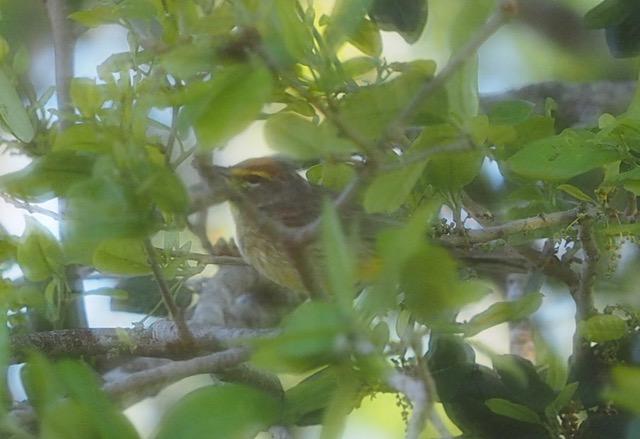 A final example was a couple weeks ago, a friend said I should come to his terrace to see all the Wood Storks 200 yards away on the edge of a golf course. They looked more like Ibis to me and my camera helped me establish that but I saw black birds which proved to be Reddish Egrets and a pair of ducks shown below
A final example was a couple weeks ago, a friend said I should come to his terrace to see all the Wood Storks 200 yards away on the edge of a golf course. They looked more like Ibis to me and my camera helped me establish that but I saw black birds which proved to be Reddish Egrets and a pair of ducks shown below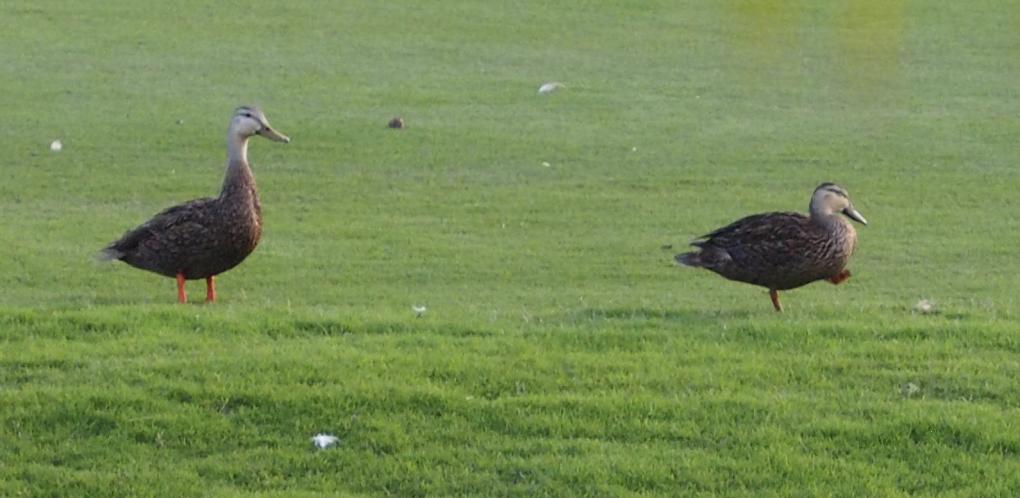 These were Mottled Duck males ID’d by Merlin.
My field notes will never be great. I probably won’t have a great life list, but I will take my telephoto and camera along whenever I go places. A little homework through ebirds and a glimpse of Merlin’s list of birds near me today will go a long way towards finding the name of more of those elusive creatures who fly so free.
These were Mottled Duck males ID’d by Merlin.
My field notes will never be great. I probably won’t have a great life list, but I will take my telephoto and camera along whenever I go places. A little homework through ebirds and a glimpse of Merlin’s list of birds near me today will go a long way towards finding the name of more of those elusive creatures who fly so free. 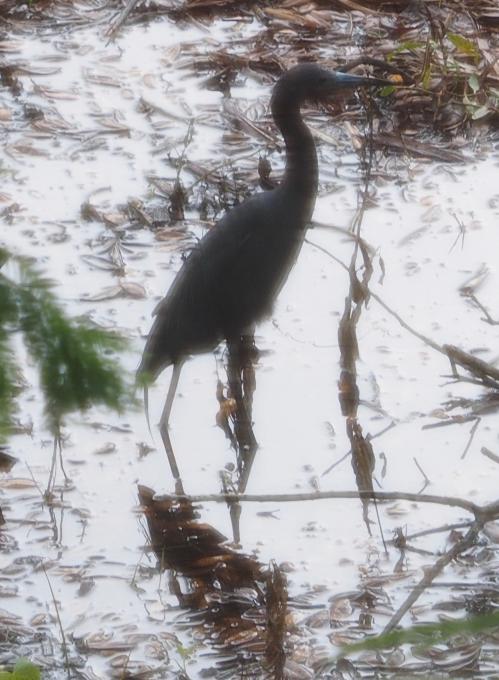 When I went over to the pond I saw redwing blackbirds and two interesting waterside sites.
When I went over to the pond I saw redwing blackbirds and two interesting waterside sites. One was a reddish egret (new bird for me this week) seen above with an Ibis. Below was where 2 of the ibis that are usually there went. Lok in the tree to their right and there was also a great blue heron in a place one might expect a raptor. He was about 40 feet above the mangrove and most smaller pines. I had seen the ibis but missed the great blue with out the aid of my 300mm of telephoto.
One was a reddish egret (new bird for me this week) seen above with an Ibis. Below was where 2 of the ibis that are usually there went. Lok in the tree to their right and there was also a great blue heron in a place one might expect a raptor. He was about 40 feet above the mangrove and most smaller pines. I had seen the ibis but missed the great blue with out the aid of my 300mm of telephoto.
 I went to familiar places and saw unfamiliar sights. Fun with birding..
I went to familiar places and saw unfamiliar sights. Fun with birding.. 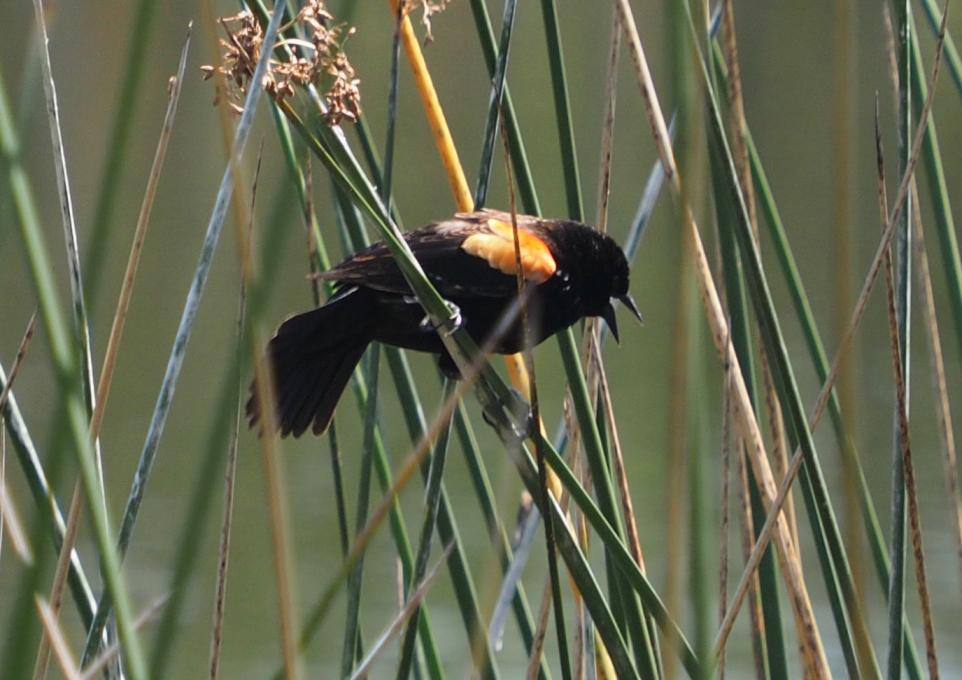
 Later in the day I was listening on my lanai and I head a sound like the end of the northern cardinal (who seems to live year rounding southwest Florida). The song was moving slowly from my right to my left. I finally caught sight of the cardinal quite low in the trees and shrubs. It was definitely a male cardinal. I didn't get his photo but have included one of my favorites from last year pretty close to the same place and time in 2019.
Later in the day I was listening on my lanai and I head a sound like the end of the northern cardinal (who seems to live year rounding southwest Florida). The song was moving slowly from my right to my left. I finally caught sight of the cardinal quite low in the trees and shrubs. It was definitely a male cardinal. I didn't get his photo but have included one of my favorites from last year pretty close to the same place and time in 2019. I guess this guy just likes the last half of his song. He didn't do the first two long notes, just started in the middle doing the staccato notes. I had thought the ever so noisy mockingbirds were the ones doing partials on the cardinal song but by paying attention for the course I found I was wrong.
I guess this guy just likes the last half of his song. He didn't do the first two long notes, just started in the middle doing the staccato notes. I had thought the ever so noisy mockingbirds were the ones doing partials on the cardinal song but by paying attention for the course I found I was wrong. 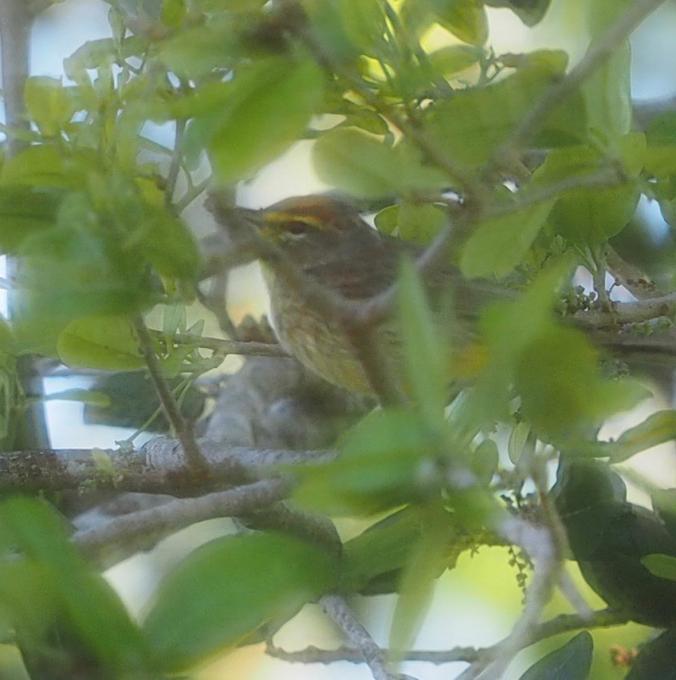
 In the few years we have lived there I have also seen numerous small birds that sometimes are numerous in the trees, and sometimes not. Merlin helped me identify this years photographable birds. I got a 2X tele extender to magnify my 150 mm lens and caught three transient warblers. Black and White Warbler was easily identified along with a great crested flycatcher who might be year-round. Two other likely candidates are shown below. I think one is a Palm Warbler the other is a Yellow Rumped Warbler.
In the few years we have lived there I have also seen numerous small birds that sometimes are numerous in the trees, and sometimes not. Merlin helped me identify this years photographable birds. I got a 2X tele extender to magnify my 150 mm lens and caught three transient warblers. Black and White Warbler was easily identified along with a great crested flycatcher who might be year-round. Two other likely candidates are shown below. I think one is a Palm Warbler the other is a Yellow Rumped Warbler.
 Warblers are hard. I need to take a whole course on them and get the associated calls implanted in my head if I want to get better at them. I have recorded several songs but found no sound identifiers that work for birds like Shazam does for recorded human music. If anyone has a good song identifier for birds let me know. I am using Merlin to guess and listen and it is not great.
Warblers are hard. I need to take a whole course on them and get the associated calls implanted in my head if I want to get better at them. I have recorded several songs but found no sound identifiers that work for birds like Shazam does for recorded human music. If anyone has a good song identifier for birds let me know. I am using Merlin to guess and listen and it is not great. 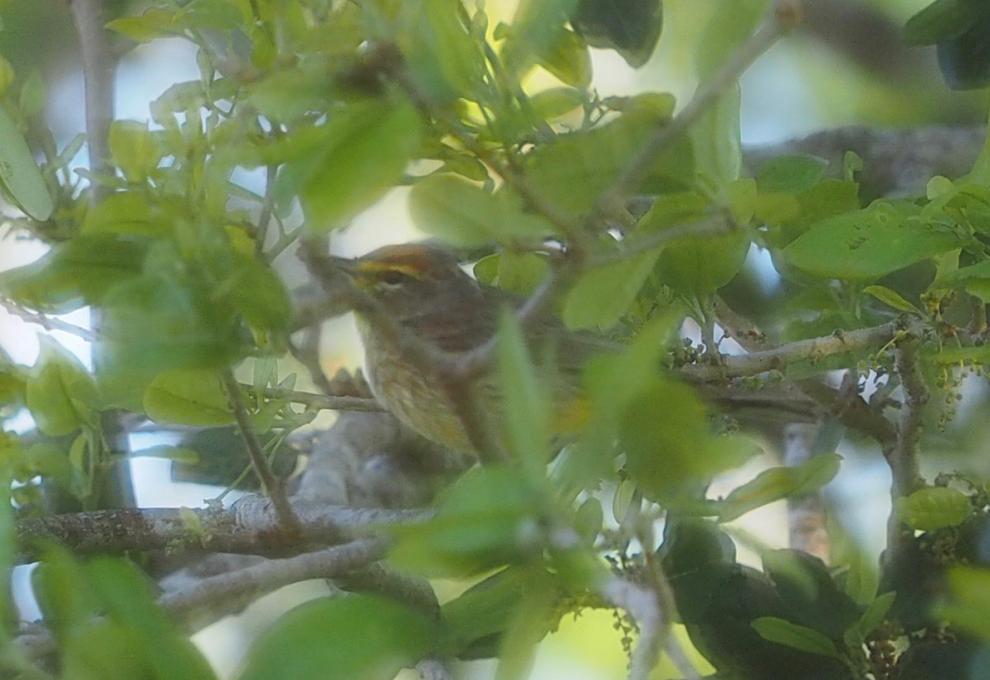 Palm Warbler
Palm Warbler
 Black and With Warbler
Black and With Warbler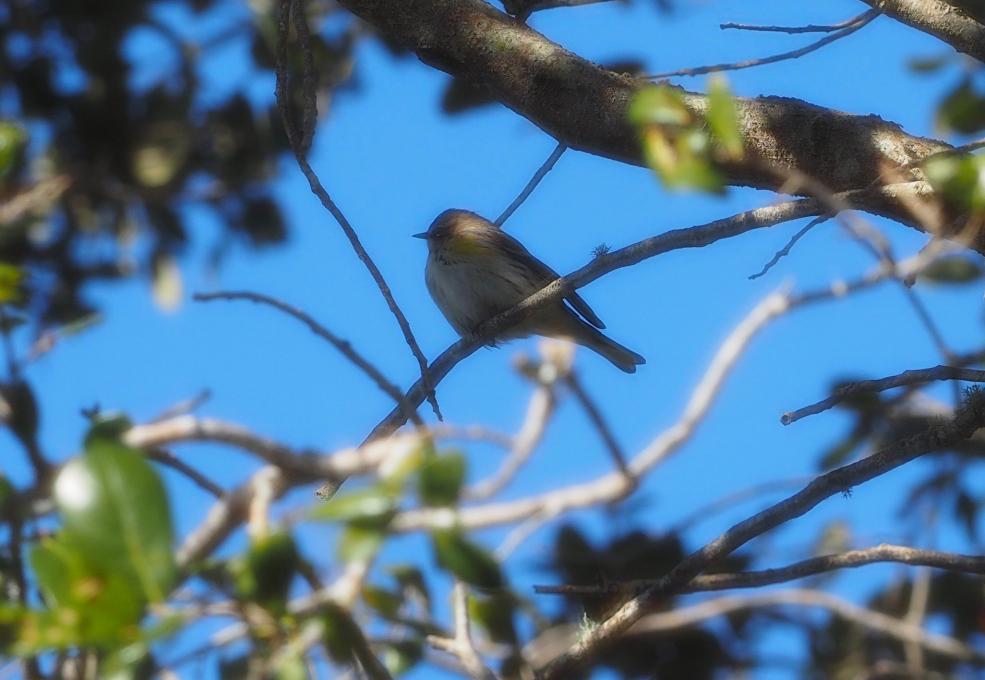 Yellow-rumped Warbler?
Different Seasons, Different Birds, Activity 2, Some who stay and some who only visit.
I am a “snowbird”. I have been a Florida resident for last 7 years who stays here in the winter and journeys north to MA for 5 months in the summer.
I noticed this year that my Live Oak trees right outside my lanai were full of small birds in Jan-March time frame but a little more-empty now that it is May. I looked through my pictures and also looked through the very long list Merlin provided to me and now better understand the reason. Some of the birds I found in the Warbler family were in the migration window when I saw them . They included a Palm Warbler, a Black and White Warbler and a Yellow Rumped Warbler or Common Yellowthroat. All show a presence in February and March and an absence in May
With the abundance of water and aquatic food, we have a wide variety of wading and fishing birds. The Great egret (my favorite) actually has a migrating population and a static population. I know Canada Geese have similar migrating and non migrating groups. Hence I can see Great Egrets all the time I am in FL and most of the time in MA. They seem to frequent a large portion of North and South America. It is hard from the animations in e-bird to see where the summer population in Massachusetts actually comes from. Most of my good bird books are in MA so I will have to do some digging to understand migration paths. One of the birds I see only rarely is the White Pelican (no good pictures) .. I have seen them in Ding Darling refuge on Sanibel and occasionally when fishing in Bonita Bay. E-bird shows a more complete picture of migration from concentrations in FL and more sparsely Mexico to South America in the winter and up the Mississippi valley to a broad part of the northern US, especially around the Great Lakes. Getting to know Merlin and e-bird has made it a lot faster to both identify and explore about birds than my long term reliance on field guides. Having participated in the Digital Revolution myself, I appreciate the immense improvements in information access for the birds.
Yellow-rumped Warbler?
Different Seasons, Different Birds, Activity 2, Some who stay and some who only visit.
I am a “snowbird”. I have been a Florida resident for last 7 years who stays here in the winter and journeys north to MA for 5 months in the summer.
I noticed this year that my Live Oak trees right outside my lanai were full of small birds in Jan-March time frame but a little more-empty now that it is May. I looked through my pictures and also looked through the very long list Merlin provided to me and now better understand the reason. Some of the birds I found in the Warbler family were in the migration window when I saw them . They included a Palm Warbler, a Black and White Warbler and a Yellow Rumped Warbler or Common Yellowthroat. All show a presence in February and March and an absence in May
With the abundance of water and aquatic food, we have a wide variety of wading and fishing birds. The Great egret (my favorite) actually has a migrating population and a static population. I know Canada Geese have similar migrating and non migrating groups. Hence I can see Great Egrets all the time I am in FL and most of the time in MA. They seem to frequent a large portion of North and South America. It is hard from the animations in e-bird to see where the summer population in Massachusetts actually comes from. Most of my good bird books are in MA so I will have to do some digging to understand migration paths. One of the birds I see only rarely is the White Pelican (no good pictures) .. I have seen them in Ding Darling refuge on Sanibel and occasionally when fishing in Bonita Bay. E-bird shows a more complete picture of migration from concentrations in FL and more sparsely Mexico to South America in the winter and up the Mississippi valley to a broad part of the northern US, especially around the Great Lakes. Getting to know Merlin and e-bird has made it a lot faster to both identify and explore about birds than my long term reliance on field guides. Having participated in the Digital Revolution myself, I appreciate the immense improvements in information access for the birds. 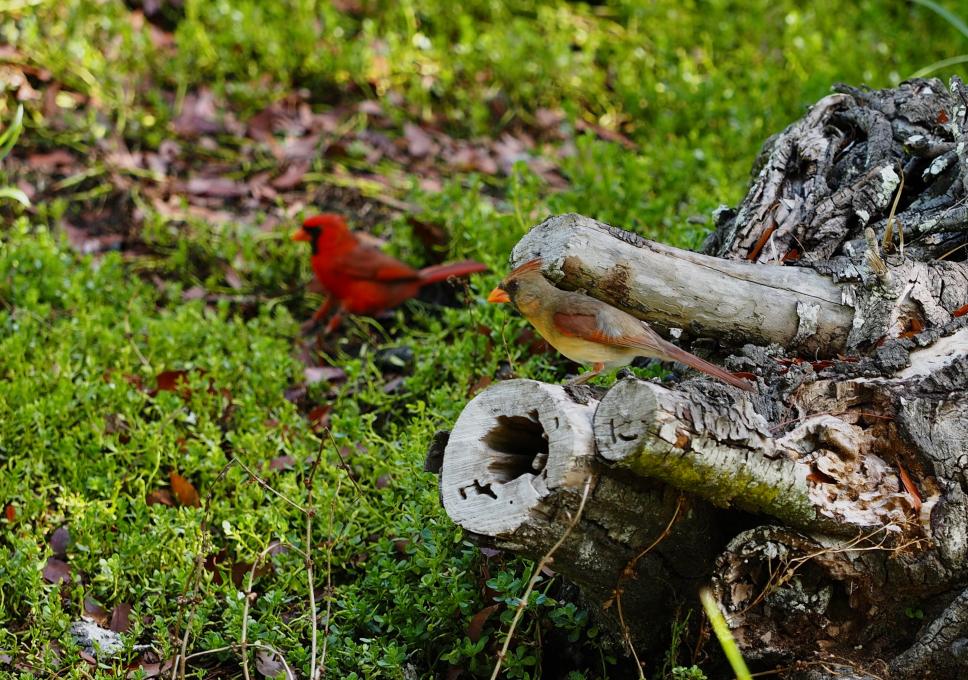 These cardinals probably stay in my neighborhood all year. They couple for life from my reading and are the species most likely to be able to photograph the male and female together around here.
Different Seasons Different Birds, Actvity 1, compare migrations of selected pairs
Northern Cardinal with Blackburnian Warbler
Northern Cardinal has a very static range. There are minor fluctuations around the fringes and within the main body of the population in the eastern 2/3 of the USA. There are also populations in southern CA, Nevada, Mexico (mostly coastal) and out into the Gulf coastal extensions of central America.
Blackburnian Warbler is a long migrator who moves from the tropical highlands of the northern parts of South America (south of where the Cardinal winters in what looks like somewhat cooler regions). And flies largely north of the heartland of the Cardinal’s range. They appear to overlap only in the summer in central to northern New England in the hillier parts of that region.
I can recommend a summer drive on route 100 through the middle of Vermont if you want to see some beautiful country and have a chance to see both birds.
Scarlet Tanager with Western Tanager
Scarlet Tanager and Western Tanager do an East West split on the United States. Their summer ranges give a reasonable wide birth to the central plains of the USA.. Western goes from west coast and highlands of Mexico and Central America in winter months to a broad swath of the Western USA and Western Provinces of Canada. The Scarlet goes further south into Western highlands of Bolivia Nicaragua and Equador and Western Brazil. It migrates north oove rCozumel and the western edge of Cuba over to Florida and settles in the northern 2/3 of the Eastern 1/3 of the US pretty much over a large part of the Applachian Trail. They seem to have very little overlap so it would be very rare to see the two in one location.
Ruby-throated Hummingbird with Rufous Hummingbird
Ruby-throated Hummingbird is the only hummingbird that makes its way to Massachusetts in the summer. I have one family that started visiting me the summer of 2018 when I was on my porch a lot due to radiation treatments and the recovery process. They had a single baby who I guessed was a female and loved my lantana. 2019 I added a feeder but am not sure they had a successful brood as I didn’t see the juvenile. They winter in Mexico and Central America and migrate to the whole eastern half of USA and most of southern Canada East of the Rockies. The Rufous winters in the northern half of the Ruby Throated’s range in Mexico but pretty much sticks to the Pacific coastal region for migration and breeding up in the Washington Oregon regions. Its path home looks to take a less coastal path visiting Idaho, Utah, Nevada, Arizona and New Mexico on its way back to Mexico wintering. Need to go Pacific side of Mexico below Baja to see them both in the winter.
Sandhill Crane with Yellow-bellied Flycatcher no confusing these.
Sandhill Crane sticks mostly to the USA and Canada including Alaska. It winters over in the US and travels to a brad swath of Canada in the breeding season. The flycatcher spends the winter in Central America and heads north mostly in the northeast USA and southeast Canada. A branch seems to take a brief trip to the eastern side of Alaska. Need to read more about them. To see both birds on the same trip one would have to go to southern Canada between the Great Lakes and Hudson Bay.
I really like the animation tool. I saw several warblers briefly in F this winter and now know it was migration time (March and April). That will set me up for Activity 2.
These cardinals probably stay in my neighborhood all year. They couple for life from my reading and are the species most likely to be able to photograph the male and female together around here.
Different Seasons Different Birds, Actvity 1, compare migrations of selected pairs
Northern Cardinal with Blackburnian Warbler
Northern Cardinal has a very static range. There are minor fluctuations around the fringes and within the main body of the population in the eastern 2/3 of the USA. There are also populations in southern CA, Nevada, Mexico (mostly coastal) and out into the Gulf coastal extensions of central America.
Blackburnian Warbler is a long migrator who moves from the tropical highlands of the northern parts of South America (south of where the Cardinal winters in what looks like somewhat cooler regions). And flies largely north of the heartland of the Cardinal’s range. They appear to overlap only in the summer in central to northern New England in the hillier parts of that region.
I can recommend a summer drive on route 100 through the middle of Vermont if you want to see some beautiful country and have a chance to see both birds.
Scarlet Tanager with Western Tanager
Scarlet Tanager and Western Tanager do an East West split on the United States. Their summer ranges give a reasonable wide birth to the central plains of the USA.. Western goes from west coast and highlands of Mexico and Central America in winter months to a broad swath of the Western USA and Western Provinces of Canada. The Scarlet goes further south into Western highlands of Bolivia Nicaragua and Equador and Western Brazil. It migrates north oove rCozumel and the western edge of Cuba over to Florida and settles in the northern 2/3 of the Eastern 1/3 of the US pretty much over a large part of the Applachian Trail. They seem to have very little overlap so it would be very rare to see the two in one location.
Ruby-throated Hummingbird with Rufous Hummingbird
Ruby-throated Hummingbird is the only hummingbird that makes its way to Massachusetts in the summer. I have one family that started visiting me the summer of 2018 when I was on my porch a lot due to radiation treatments and the recovery process. They had a single baby who I guessed was a female and loved my lantana. 2019 I added a feeder but am not sure they had a successful brood as I didn’t see the juvenile. They winter in Mexico and Central America and migrate to the whole eastern half of USA and most of southern Canada East of the Rockies. The Rufous winters in the northern half of the Ruby Throated’s range in Mexico but pretty much sticks to the Pacific coastal region for migration and breeding up in the Washington Oregon regions. Its path home looks to take a less coastal path visiting Idaho, Utah, Nevada, Arizona and New Mexico on its way back to Mexico wintering. Need to go Pacific side of Mexico below Baja to see them both in the winter.
Sandhill Crane with Yellow-bellied Flycatcher no confusing these.
Sandhill Crane sticks mostly to the USA and Canada including Alaska. It winters over in the US and travels to a brad swath of Canada in the breeding season. The flycatcher spends the winter in Central America and heads north mostly in the northeast USA and southeast Canada. A branch seems to take a brief trip to the eastern side of Alaska. Need to read more about them. To see both birds on the same trip one would have to go to southern Canada between the Great Lakes and Hudson Bay.
I really like the animation tool. I saw several warblers briefly in F this winter and now know it was migration time (March and April). That will set me up for Activity 2. 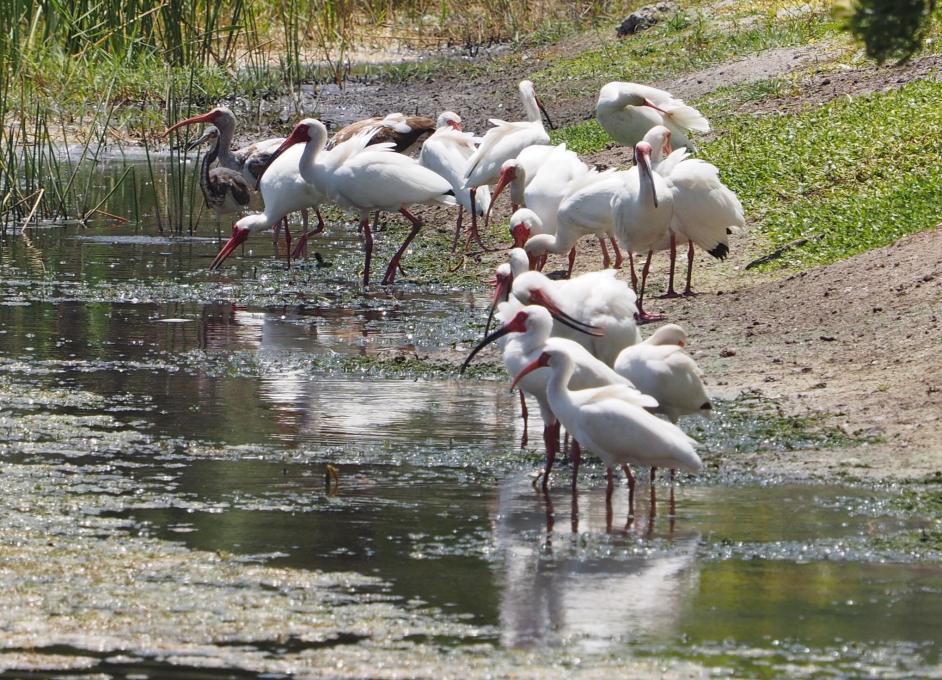
 A bluejay came by but failed to get his picture taken.
Next stop was a spot my wife told me "always has lots of white birds. There are two ponds part of the irrigation system and interconnected ponds for our golf course. A brown thrasher flew by as I was walking over the grass to get closer to a small group of wading birds about 500' away. As there are several large alligators around and it is the beginning of mating season, I did not go as close as I might have in January.
The birds largely stayed in the same place and I took several photos over a few minutes. My 150X telephoto on Olympus E-M1 helped me see things when I got back to my computer that I didn't see with my bare vision. The first grouping has a little blue heron and a great egret and several ibis. What I hadn't seen before was the snowy egret landing. Black beak and yellow feet were visible by chance in the landing.
A bluejay came by but failed to get his picture taken.
Next stop was a spot my wife told me "always has lots of white birds. There are two ponds part of the irrigation system and interconnected ponds for our golf course. A brown thrasher flew by as I was walking over the grass to get closer to a small group of wading birds about 500' away. As there are several large alligators around and it is the beginning of mating season, I did not go as close as I might have in January.
The birds largely stayed in the same place and I took several photos over a few minutes. My 150X telephoto on Olympus E-M1 helped me see things when I got back to my computer that I didn't see with my bare vision. The first grouping has a little blue heron and a great egret and several ibis. What I hadn't seen before was the snowy egret landing. Black beak and yellow feet were visible by chance in the landing. A few minutes later the great heron was gone but the little blue and ibis were joined by what I had always thought were coots but today learned they were common gallinules. The long green legs identify the female as such. My homework for tonight is to figure out what a gallinule is all about.
A few minutes later the great heron was gone but the little blue and ibis were joined by what I had always thought were coots but today learned they were common gallinules. The long green legs identify the female as such. My homework for tonight is to figure out what a gallinule is all about.
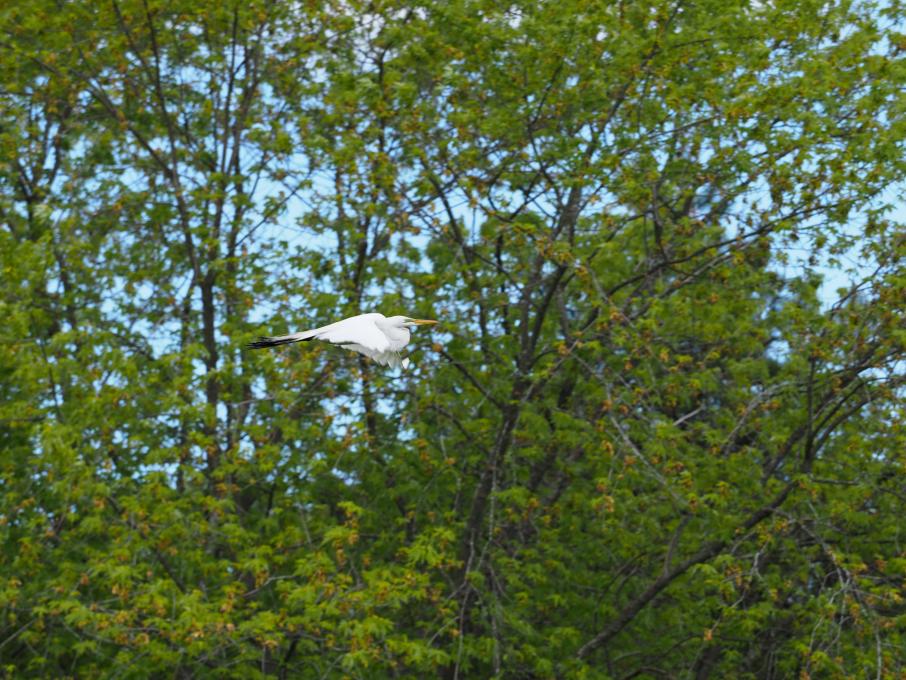 In Florida there are more snowy egrets who are almost the same size but have a black beak and yellow feet. The first one below I original thought was a grgreat
In Florida there are more snowy egrets who are almost the same size but have a black beak and yellow feet. The first one below I original thought was a grgreat 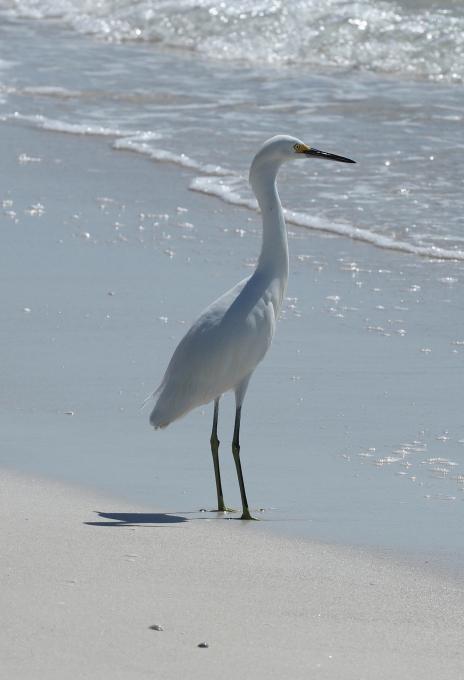 white egret but think it might be a female. As with most wading birds, their feet are often hidden in the sand or water.
white egret but think it might be a female. As with most wading birds, their feet are often hidden in the sand or water.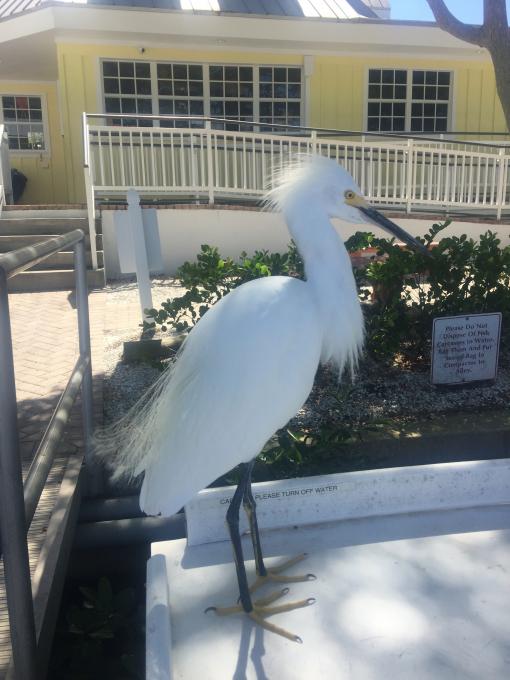 The second snowy egret picture is much more identifiable. He was waiting at a fish cleaning table for some free handouts. I am pretty sure he was showing his flume to impress a nearby great blue heron and a bunch of pelicans that he should be given more respect and maybe to the captain and mate that he should be given more fish scraps.
The second snowy egret picture is much more identifiable. He was waiting at a fish cleaning table for some free handouts. I am pretty sure he was showing his flume to impress a nearby great blue heron and a bunch of pelicans that he should be given more respect and maybe to the captain and mate that he should be given more fish scraps. 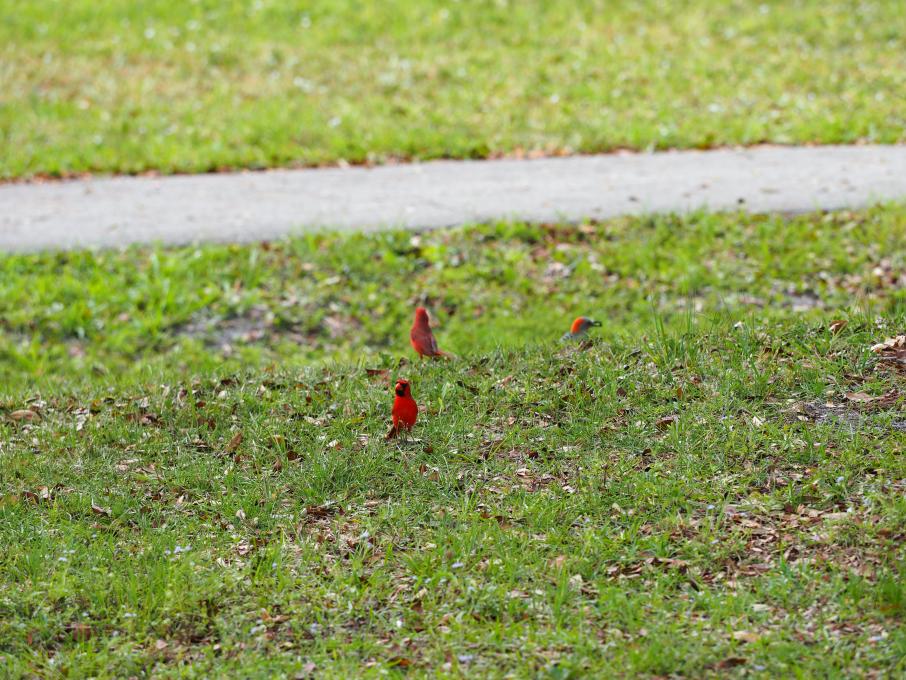
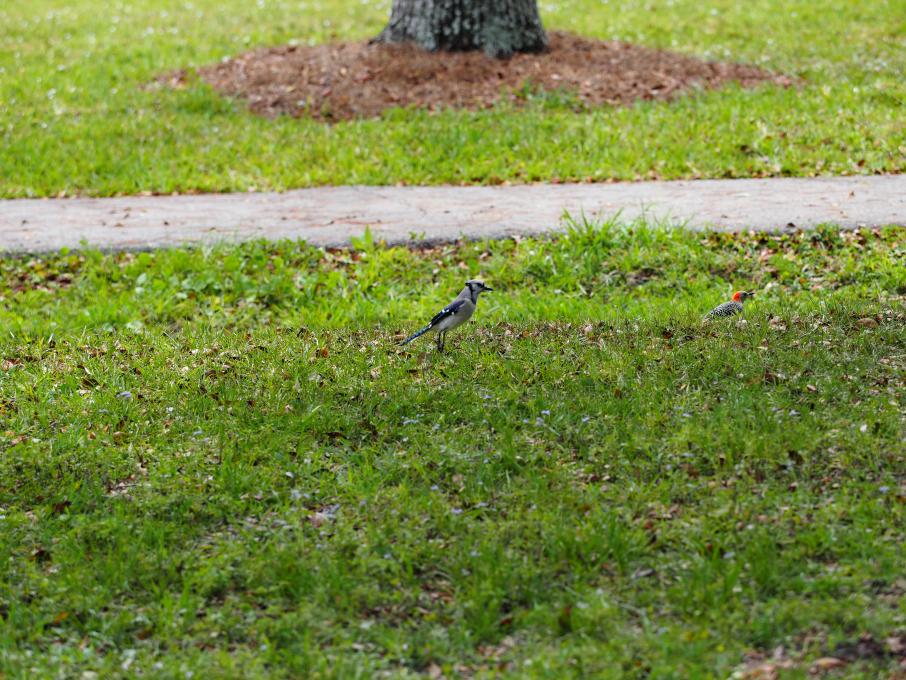
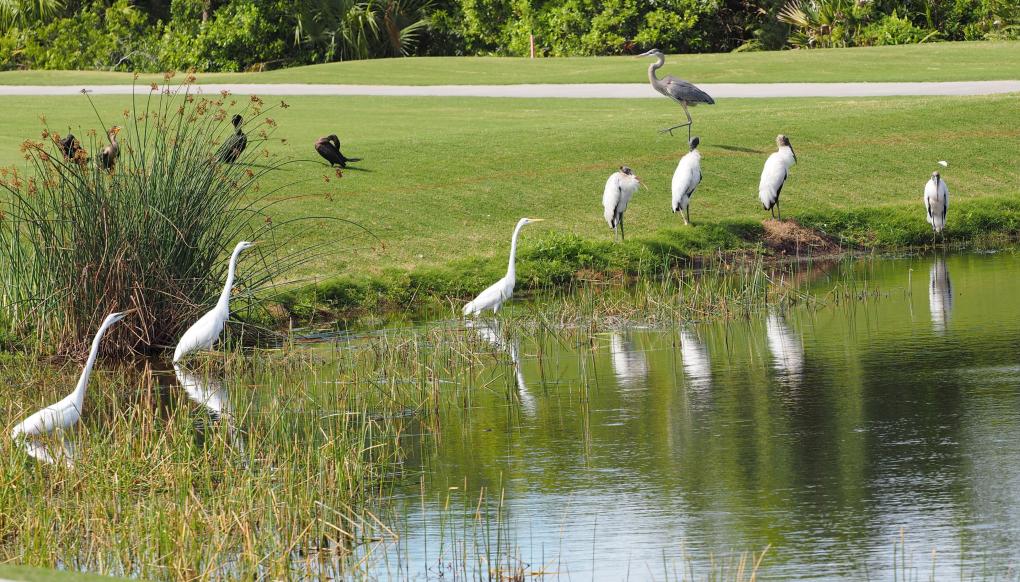 Bird ID Practice:
Activity 1 Shape differences. This is one of my favorite pictures and the shape differences are readily observable. The sleek smooth and slender shape of the the egret is easily differentiated from the stocker, broader body, more substantial bill and broader all over scope of the wood stork. The great blue heron in the back is intermediate between the two others. The ducks well they look like ducks out of water in this case.
Bird ID Practice:
Activity 1 Shape differences. This is one of my favorite pictures and the shape differences are readily observable. The sleek smooth and slender shape of the the egret is easily differentiated from the stocker, broader body, more substantial bill and broader all over scope of the wood stork. The great blue heron in the back is intermediate between the two others. The ducks well they look like ducks out of water in this case.
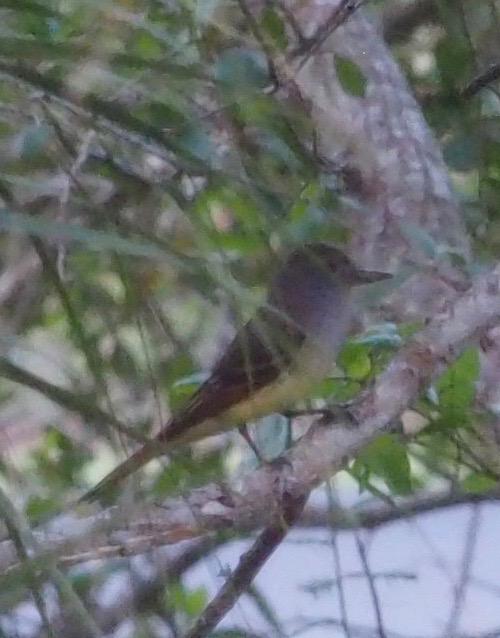
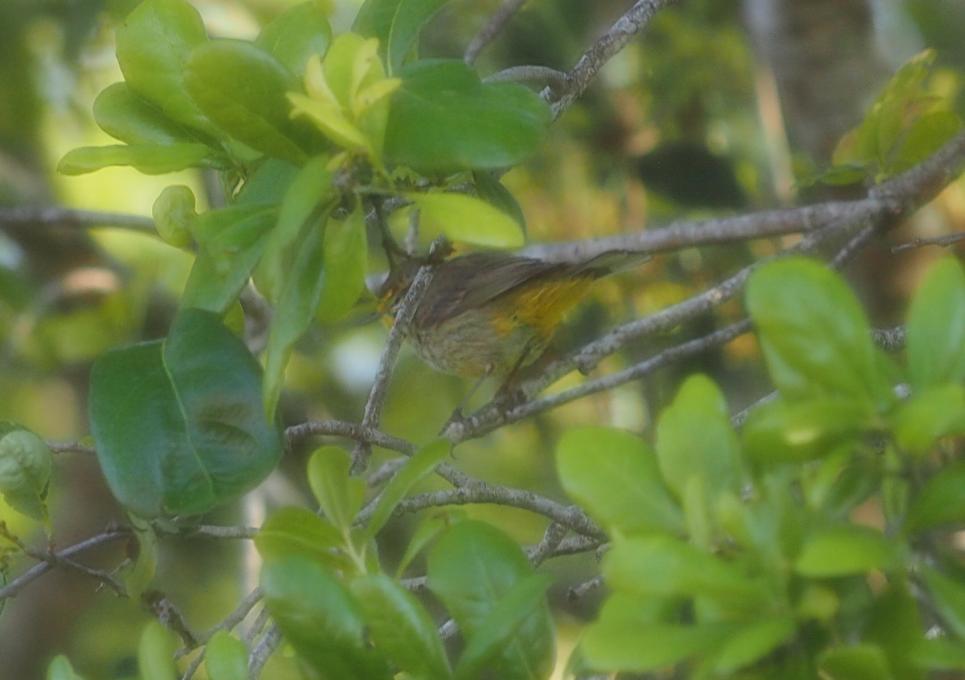 Activity 2 Color is the color yellow. My first use of Merlin helped me ID the great crested flycatcher. He is bigger than the goldfinch (everyone knows what they look like) and this warbler. The flycatcher has four (or 5) colors (blue shoulders, black wing, yellow belly, white and rusty colored tail. I never got a good enough picture of the warbler to firmly identify it, but the size and shape and splashes or yellow pretty firmly classify it. The goldfinches are the bright spots of yellow who arrive in MA in early spring and stay until they finish eating all of my sunflowers.
Activity 2 Color is the color yellow. My first use of Merlin helped me ID the great crested flycatcher. He is bigger than the goldfinch (everyone knows what they look like) and this warbler. The flycatcher has four (or 5) colors (blue shoulders, black wing, yellow belly, white and rusty colored tail. I never got a good enough picture of the warbler to firmly identify it, but the size and shape and splashes or yellow pretty firmly classify it. The goldfinches are the bright spots of yellow who arrive in MA in early spring and stay until they finish eating all of my sunflowers. 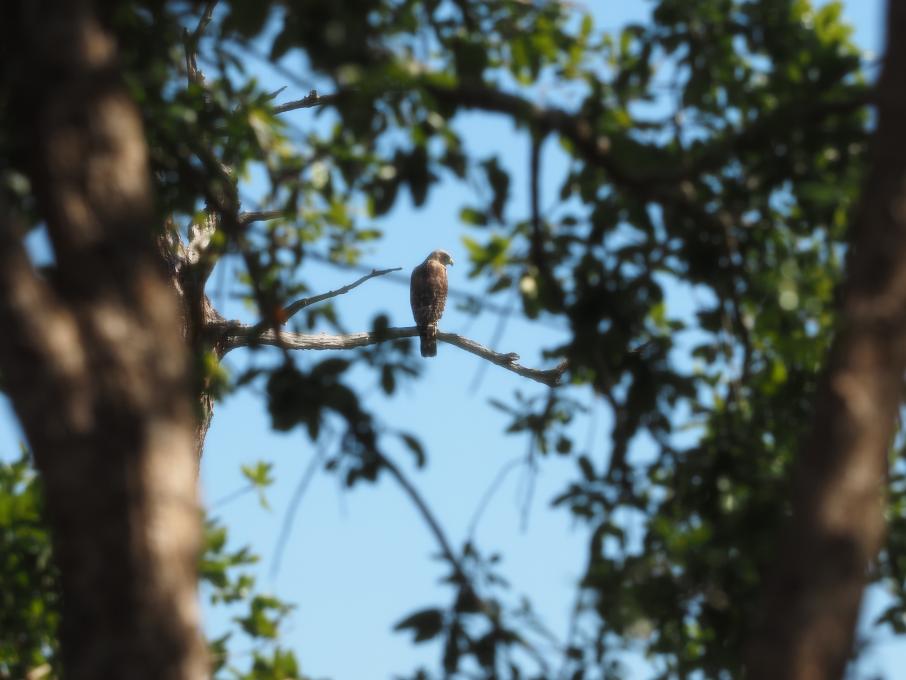 Bird ID Activity 1: This is a photo from last year just after I got my 40-150 sense for Olympus. I think this is a coopers hawk from my previous searches through the bird guides that I have. It is a juvenile that I saw hunt in the neighborhood a few times. A feature not captured in a photo is its fan shaped tail that appears white with black stripes, ie the white is 50% broader than the black on the tail. Merlin from my descriptions suggests a red shouldered hawk is more likely in Florida.
Pertinent to this exercise though, another bird hunts in the neighborhood as well. It is a little smaller with a long forked tail. It is a swallow tailed kite. I don't have a good picture but once you have seen one fly nearby, it is impossible not to recognize.
Bird ID Activity 1: This is a photo from last year just after I got my 40-150 sense for Olympus. I think this is a coopers hawk from my previous searches through the bird guides that I have. It is a juvenile that I saw hunt in the neighborhood a few times. A feature not captured in a photo is its fan shaped tail that appears white with black stripes, ie the white is 50% broader than the black on the tail. Merlin from my descriptions suggests a red shouldered hawk is more likely in Florida.
Pertinent to this exercise though, another bird hunts in the neighborhood as well. It is a little smaller with a long forked tail. It is a swallow tailed kite. I don't have a good picture but once you have seen one fly nearby, it is impossible not to recognize.
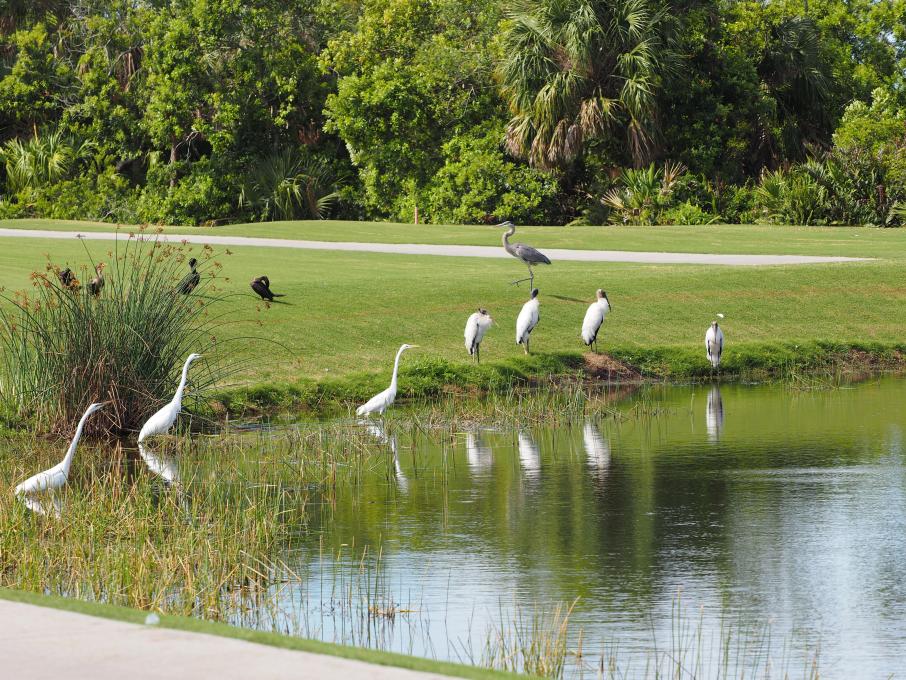
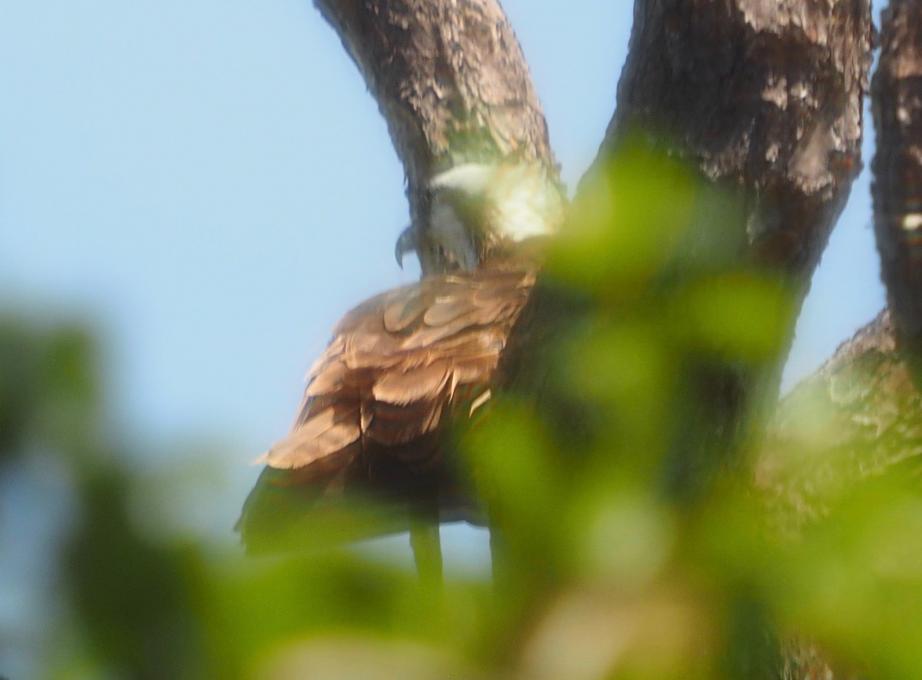 I also saw a bird I had not seen before. It is a great crested flycatcher and he/she was here to eat the bumper crop of large white moths that had come out the last week or so.
I also saw a bird I had not seen before. It is a great crested flycatcher and he/she was here to eat the bumper crop of large white moths that had come out the last week or so.
